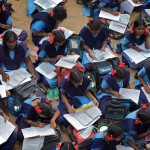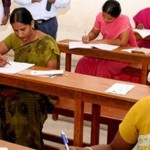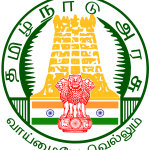
1. Consider the following statements and choose the correct code
I. Rabindranath Tagore stood for a national scheme of education
II. In 1901, a school was established at Shanti Niketan
Choose the correct answer from the options given below :
A) I is correct II is wrong
B) II is correct I is wrong
C) I and II are correct
D) Both I and II are wrong
Explanation : Ans : (C)
Rabindranath Tagore insisted that education should be provided in Swadeshi languages.
In 1901 Tagore moved to Shanti Niketan to found an ashram and school. He stood for a national scheme of education.
On 5 November 1905, at the initiative of the Dawn society, the National council of education was formed. In August 1906, Bengal National college and a school were founded.
2. Which one of the following is not a federal feature ?
A) Dual government
B) Division of powers
C) Rigid constitution
D) Single citizenship
Explanation : Ans : (D)
The very 1st Article of our Constitution says that “India, that is, Bharath, shall a Union of States”. Our Constitution is federal in nature in ordinary time but unitary in times of emergency. The federal features are two governments, division of powers, written constitution, supremacy of constitution, rigidity of constitution, independent judiciary and bicameralism. Single citizenship is a non-federal feature.
3. To define “Poverty Line” in India.
The Seventh Finance Commission used a concept called
A) The above poverty line
B) The augmented poverty line
C) The below poverty line
D) The family planning
Explanation : Ans : (B)
The Seventh Finance Commission (1978) has questioned the validity of earlier estimates of poverty on the ground of their narrowness. To obviate the problem, the seventh Finance Commission has developed the concept of “augmented poverty line”.
To have a comprehensive measure of poverty the benefits of public expenditure is added to the private consumption expenditure for calculating the augmented poverty line.
The augmented poverty line envisages the addition of the monthly private expenditure to the per capita monthly public expenditure by each State Government under the following categories :
(i) health and family planning,
(ii) water supply and sanitation,
(iii) education,
(iv) administration of police, jails and courts,
(v) roads and
(vi) social welfare.
The estimates made by the Seventh Finance Commission, based on the comprehensive definition of poverty, indicated that the 53 percent of the rural and 51 per cent of the urban population lived below the poverty line.
The estimates of the Commission reveals that in 1970-1971, the percentage of people below the augmented poverty line was 52. The percentage of people below the poverty line is expected to decline to 26% by the end of the Seventh Five year plan and subsequently to 5% by the turn of the century.
4. Which of the following continents is a region of great biodiversity ?
A) North America B) South America
C) India D) New Zealand
Explanation : Ans : (B)
South America is located in the Western Hemisphere south of Central America. South America is the fourth largest continent in area. Stretching over 7,000 miles in length, it lies between the Atlantic and Pacific Oceans.
South America’s extreme geographic variation contributes to the continent’s large number of biomes. A biome is a community of animals and plants that spread over an area with a relatively uniform climate.
Within a few hundred Kilometres, South America’s coastal plain’s dry desert biome rises to the rugged alpine biome of the Andes mountains. One of the continent’s river basins (the Amazon) is defined by dense, tropical rain forest, while the other (parana) is made up of vast grasslands.
With an unparalleled number of plant and animal species, South America’s rich biodiversity is unique among the world’s continents.
Physical Features :
Mountains : The Andes Mountains are among the highest in the world. They extend over 4,500 miles in the western part of South America. The Andes were once the basis of the Inca Empire.
Grasslands and plains : Mountains and poor soils make much of South America’s land unproductive. One exception is the pampas of Argentina and Uruguay. The pampas provide large areas of fertile soil for growing crops and grazing cattle.
Rain forests : Rain forests are located on the east coast of Central America and the northern part of South America. They have warm, humid climates. The Amazon Rain forest, the world’s largest tropical rain forest, is in Brazil. Each year, part of the rain forest is being cut down (deforestation) to provide land for ranches and farms.
Bodies of Water : The Amazon River is the second longest river in the world. In addition, South America has the Orinoco River and the Rio de la Plata. A large percentage of South America’s population lives on or near these river systems.
Climate : Much of South America is warm because it lies near the equator. However, because of its mountains and ocean winds, many places in South America have comfortable temperatures. Some of the greatest concentrations of people can be found in higher elevations where temperatures are cooler.
5. Which rule is used for the order of filling of orbitals ?
A) Hunds rule B) (n + l) rule
C) (n – l) rule D) (2n + l) rule
Explanation : Ans : (B)
Aufbau Principle [(n + l ) rule] : The molecular orbitals are filled in the increasing order of their energies, starting with orbital of least energy.





